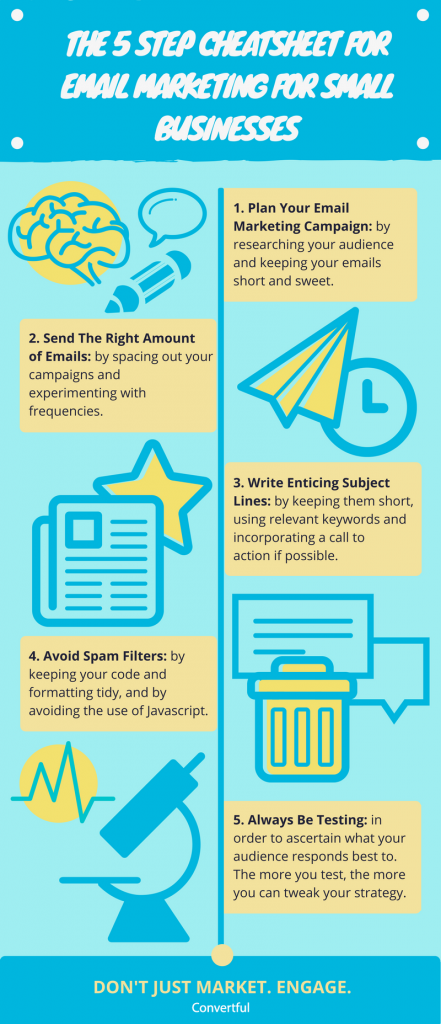Email Marketing is Alive, Well and Practical
Email marketing remains a lucrative endeavor for small businesses. The total of 4.9 billion email accounts expected to be active across the world by the end of 2017.
To build your email subscriber list, you’re going to need an email marketing strategy. The strategy to reach out to your subscribers with value. Value-packed emails, special offers and other forms of exclusive content.
Email marketing was a mainstream form of marketing for almost twenty years. Even though, it can still be a daunting phrase for some small business owners. So to get you started, here’s a five-part cheat sheet to email marketing for small businesses.
5 Step Cheat Sheet For Small Businesses
1. Planning Your Email Marketing Campaign
Every email you send must be worth reading, but as you might imagine, that’s easier said than done.
First and foremost, your best bet is to view each email as a compacted blog post.
To make each email as meaningful as a blog post, here are a few things to consider:
- Know Your Audience: offer them content that resonates with them, in the same tone you use on your blog or website
- Make Your Emails Valuable: don’t restrict your emails to just being gateways to your website. Give your subscribers relevant content, tips and insights into your industry within the email itself.
- Short and Sweet: provide bitesize stats and facts for easy digestion and offer short and actionable pieces of advice
- Calls to Action: want to drive traffic to your website or landing page? Make your call to action buttons clear, but don’t make them the recurring focal point of your emails
Your emails also need to be concise. By their nature, emails are meant to be quick and effective mediums of communication. So, don’t shoot your marketing campaign in the foot by sending out thousands of words in one email.
You also want your emails to be truly worth reading.
Sure, you want your subscribers to click through to your website. But even your most loyal customer doesn’t want to receive emails about whatever this week’s “featured product” is. Instead, a short article on the benefits of one of your products might bring better results.
Putting the actual words to one side, let’s talk about formatting.
You don’t want to send out an email with various fonts and text sizes. Your images shouldn’t be poorly aligned or sized. To keep your brand looking professional, ensure that formatting is clean and consistent. Stick to this approach throughout all your email marketing campaigns.
Finally, you’ll want to ensure that your email templates are mobile responsive. Mobile devices now represent 55 percent of email opens. This shouldn’t be a problem if you’re using popular email marketing solutions. For example, Mailchimp or MailJet.
For more tips on how to hone your email copy, Copyblogger has some great insights.
2. Send The Right Amount of Emails
Now, you have the content and formatting of your email established. Next, you’ll need to figure out how often to send out emails to your subscriber base.
To highlight the importance of getting this right, here’s a study worth paying attention to:
A survey done by TechnologyAdvice asked 472 U.S. adults. The question was “For what reasons have you marked a business’ emails as spam?”, “For what reasons have you marked a business’ emails as spam?”
Results were interesting. 45.8 percent of respondents marked emails as spam because the company was sending them too often.
The only question is, how often is too often?
In reality, there is no right answer. Each industry and audience are different. Your best bet is to start conservatively. First, send emails once every two weeks. Then you can experiment with campaigns that are closer together. You can analyze how the frequency affects your open and click through rates.
But one thing is for sure. Always space out your emails by at least a week to avoid flooding your subscriber’s inboxes.
On the other hand, be wary of allowing long periods of time to pass between each email marketing campaign. If your subscribers aren’t regularly reminded of how good your content is — they’ll essentially become stale subscribers. That means they’re no longer interested in your brand. When you finally send another email to them, your open rates will fall. Unsubscriber rates will soar respectively.
To recap, here’s what to consider when planning the frequency of your email campaigns:
- Don’t Flood Your Audience With Emails: 45.8 percent of respondents marked emails as spam because the company was sending them too often.
- Experiment With Your Frequency: Each audience will react differently. You need to ascertain what your audience likes, and then go with that.
- Don’t Keep Your Audience Waiting: At the same time, don’t allow long periods of time to pass between each email. Your audience might just disengage entirely.
For a more in-depth analysis of the best email marketing campaign frequencies, check out Campaign Monitor’s study.
3. Write Enticing Subject Lines
Your subject line plays a vital role in your email campaign’s lifecycle. If the subject line sucks, nobody will click on it in order to read your email. But if it pops, your subscribers will be eager to learn more.
Writing a good subject line is a lot like writing a good blog post title. The key is to grab the reader’s attention without sacrificing the message. Here are a few tips to guide your subject line writing strategy:
- Relevant Keywords. The best way to convince your subscribers to open the email is to give them more of interesting content. The same content that made them subscribe in the first place. As for writing a subject line, include keywords that resonate with your subscribers.
- Calls to Action. Call to action copy isn’t reserved for buttons. You can also call your audience to action within your subject line. For example, you could write, “Join Our Free Webinar”
- Shorter and Sweeter. Remember how we said your email copy needs to be short and sweet? Well, your subject line must be shorter and sweeter. 50 characters should be your limit since any more than that will be cut off on mobile devices.
Above all though, you’ll have to think outside the box in order to deliver enticing subject lines for every email you send. In time, your creativity should lead you to better open rates.
Furthermore, many email clients display the first few words of an email to the user before they open it. This is particularly true on mobile devices. Thus, it’s worth optimizing your opening few words to entice people to click.
A great way to do that is through personalization. At its most basic level — address each of your subscribers by their first name at the start of the email.
Personalization is a proven way to get more email opens and click throughs. In fact, personalized email messages improve click-through rates by an average of 14 percent and conversions by 10 percent.
To learn more about writing engaging subject lines, the Hubspot team knows a thing or two.
4. Avoid Spam Filters
Email clients like Gmail or Outlook have built-in spam filters. If they think your emails are spammy, they’ll throw them in your subscriber’s junk folder. Even before your subscriber gets a chance to read your subject line.
Once again, try to use a mainstream email marketing platforms. They will, by default, help your emails to stay out of junk folders. The code and formatting will be mostly taken care of (unless you add in your own messy code thereafter).
Here’s a quick list of things to avoid if you want to skip past those pesky spam filters:
- Stay away from salesman-like words such as, “Buy Now” or “Save 10%” in your subject lines.
- Avoid including Javascript, RSS feeds and lead generation forms within your emails
- Keep your coding and formatting neat and tidy
- Limit your use of images — particularly if you aren’t using much text.
To learn more about how to avoid spam filters, Pardot has an excellent guide.
5. Always Be Testing
As previously mentioned, every audience is unique. Your email subscriber list may not respond to a certain tactic. The tactic that might work wonders for other businesses.
The solution is to always be testing.
Popular email marketing platforms will allow you to run split tests (otherwise known as A/B tests). You can test things like subject lines, email copy, and call to action buttons. These tests will allow you to see how your audience reacts to slight changes in your emails.
Based on the ongoing results, you’ll soon get to know your audience. Know exactly what encourages them to open emails, click through to the website, and convert. And in turn, you’ll also know what makes them turn on their heels and run.
- Carry out A/B Tests. Most email marketing platforms will allow you to do this with relative ease.
- Study The Results. After a few tests, study the results to see what resonated with your audience, and what didn’t.
- Make Changes. Once you know what your audience responds to best, you can make knowledge-based tweaks to improve your return on investment (ROI).
Just remember, the more you test, the faster you’ll know.
To learn more about A/B testing, check out MailChimp’s explainer page.
The Final Checklist
Now that you have the basics in place, it’s time to go over your final checklist. Ensure that your email marketing campaign will be a success.
Here’s everything you need to check off before you click the send button:
- Ensure each email you send provides valuable information. The same way you would with a blog post.
- Use a reputable email marketing platform that provides well designed responsive templates.
- To avoid spam filters, avoid salesman-like vocabulary.
- Write an attention-grabbing subject line.
- Check that the formatting is clean and consistent.
- Test your email by sending it to yourself first.
- Double check that you’re sending the email to the right subscriber list.
- Hit send!
Don’t Just Market, Engage
When subscribers receive your marketing emails, they shouldn’t feel like you’re asking anything of them.
Instead, your email marketing subject line should provide genuine value. Should be relevant, useful and actionable. Once you have that covered, along with the final checklist above, you’re all set to start your campaign.
If you ever feel like your email marketing campaigns aren’t hitting the mark — persist. After all, U.S. consumers interact with an average of 11 brands through email each day. The market is definitely there for the taking.

To recap, here’s the five-step cheat sheet in short form:
- Plan Your Email Marketing Campaign. Research your audience and keep your emails short and sweet.
- Send The Right Amount of Emails. Space out your campaigns and experiment with frequencies.
- Write Enticing Subject Lines. Keep them short, use relevant keywords and incorporate a call to action if possible.
- Avoid Spam Filters. Keep your code and formatting tidy, and avoid the use of Javascript.
- Always Be Testing. To ascertain what your audience responds best to. The more you test, the more you can tweak your strategy.
Still have some queries about sending your first marketing email? Let us know how we can help in the comments section below!
 Why Noreply Email Address Is BAD for Email Marketing and What to Do Instead
Why Noreply Email Address Is BAD for Email Marketing and What to Do Instead Top 7 Free Digital Marketing Courses in 2019
Top 7 Free Digital Marketing Courses in 2019